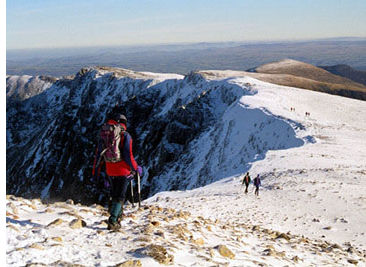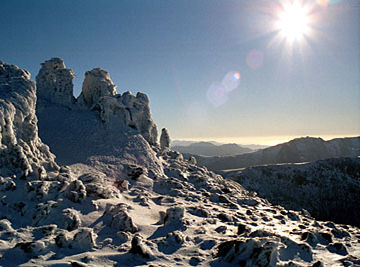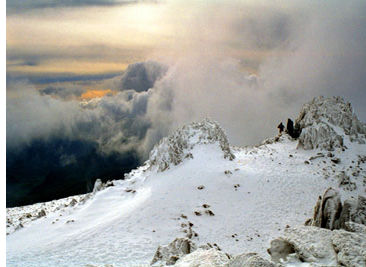| |
|
Mountain photography can be tricky,
how do you avoid having those stunning views look flat and
dull when you get home and look at the photos? Travel photographer
Simon Kirwan shares some tips for budding
mountain snappers! Check out his website, The
LightBOX for more amazing mountain photography from his
travels to the Himalayas, the Alps, and even North Wales!
Come back for more! This is the
first in an occasional series of articles on travel photography
that Simon is writing for travel-quest.
|
|
|

Main search
page
Latest
travel news
New additions
Editorials
Special
Searches
Submit
a site
Travel Co Admin
Contact
travel-quest
|
|
|
Photographic courses and holidays
Take a look at our photographic
section for companies offering photographic courses and
holiday breaks.
|
|
Recommended Books
Galen Rowell's Inner Game of Outdoor
Photography is based on articles the author has written
for "Outdoor Photographer" magazine. In the book he explains
artful composition as well as offering technical advice
on such things as pushing film to extremes; and when and
how to use flash. Backed up with advice on such things as
travelling light and packing your camera gear.

Check
price in GB£
Check
price in US$
For those on a more limited budget we suggest
Photographing Landscapes by John
Hedgecoe. This well illustrated book provides practical
tips designed to help you to enhance the quality of your
landscape photograpy by improving your picture-taking technique.

Check
price in GB£
Check
price in US$
|
|
|
|
|
Mountain photography – how to take good pictures
when out in the hills
 Mountains
are by nature photogenic, but it is not always easy to capture their
scenic grandeur in a photograph. The first requirement is to use
decent equipment – simple point-and-shoot cameras, either using
film or digital, can yield good results, but for most purposes,
a good quality 35 mm camera with a selection of lenses is necessary. Mountains
are by nature photogenic, but it is not always easy to capture their
scenic grandeur in a photograph. The first requirement is to use
decent equipment – simple point-and-shoot cameras, either using
film or digital, can yield good results, but for most purposes,
a good quality 35 mm camera with a selection of lenses is necessary.
I use a 24 mm or 50 mm lens on an Olympus OM1 (still going strong
after 27 years!), or a 35 mm–80 mm zoom on a Canon EOS300,
usually at its widest setting. Wide angle lenses are necessary to
include the large physical area occupied by mountain scenes, and
impart a sense of scale and space. It is a good idea to include
some foreground detail like figures or buildings to emphasise the
scale of the scene.
I generally shoot film, and get Kodak Picture CD processing, which
gives me the best of both digital and traditional worlds, in that
I get a set of prints, negatives for archival, and a set of superb
Kodak scans suitable for use on my web site with little adjustment.
These can also be used to produce photo-quality prints from the
PC.
 The
primary consideration affecting the quality of any photograph is
lighting, even more so when shooting landscapes. The lighting on
a particular scene can change dramatically depending on several
factors – the weather, time of day, season of the year, and
location of the scene. The
primary consideration affecting the quality of any photograph is
lighting, even more so when shooting landscapes. The lighting on
a particular scene can change dramatically depending on several
factors – the weather, time of day, season of the year, and
location of the scene.
Generally speaking, lighting for mountain photography is better
early or late in the day, and from autumn through to spring, when
the sun is low in the sky, producing side-lighting which emphasises
the shape of the mountain. During the middle of the day, and particularly
in summer, the sun tends to be very overhead, and produces lighting
which flattens the contours of the landscape.
Sunlight on a crisp winters day, with snow on the peaks, often
produces the most satisfying results – the air is cold and
clear, intensifying the blue of the sky, and definition of the landscape
is at its most pronounced. In summer, heat produces a dust and photochemical
haze in the atmosphere, reducing definition, and causing the sky
to appear grey and colourless, even in bright sunshine.
It is also important to remember that the light moves around the
points of the compass from dawn to dusk, rising in the east, passing
through south in the middle of the day, and setting in the west.
 Light
illuminates different facets of a mountain at differing times of
day, so that an east-facing mountain will receive light in the morning,
west-facing will be lit in the afternoon, and south-facing will
receive light all day. Often a shot from a desired viewpoint must
be timed to suit the timing when the light will be at its most advantageous
– side-lighting generally yields better results than flat over-the-shoulder
lighting. Light
illuminates different facets of a mountain at differing times of
day, so that an east-facing mountain will receive light in the morning,
west-facing will be lit in the afternoon, and south-facing will
receive light all day. Often a shot from a desired viewpoint must
be timed to suit the timing when the light will be at its most advantageous
– side-lighting generally yields better results than flat over-the-shoulder
lighting.
Finally, don't leave the camera behind because the weather is bad
– often the best results occur when the light suddenly breaks
through clouds after rain, glinting off wet rock. Cloud formations
often provide interest and drama to otherwise mediocre views, so
don't just wait for a perfect summers day, get out there and start
shooting!
|
Simon Kirwan is
a professional travel photographer, web developer and writer,
whose work has appeared in the Rough Guide, Ultrafit magazine
and many other publications. After almost twenty years in
advertising photography, working for clients like adidas,
Liverpool FC, Kelloggs, Littlewoods and Great Universal Stores,
Simon now divides his time between photography, travelling,
mountain walking, and developing web sites. Five years ago,
Simon set up The
LightBOX, one of the UK's first homegrown photo gallery
web sites, and many of the UK's top advertising photographers
displayed portfolios of images on its pages. The
LightBOX has featured in The Guardian, and The Guardian
book Photo Sources on the Web, and is now one of the premier
UK travel and mountain photography sites, featuring images
from Africa; the Nepal Himalaya & Mount Everest; the French
Alps & Mont Blanc; the Polish Tatras; Mallorca & Gran
Canaria; Wales & Snowdonia; with new galleries being added
all the time.
|
© Simon Kirwan – The
LightBOX 2001/2
This article also appears on Simon Kirwan's
site at The
LightBOX. Reproduced with permission.
|

